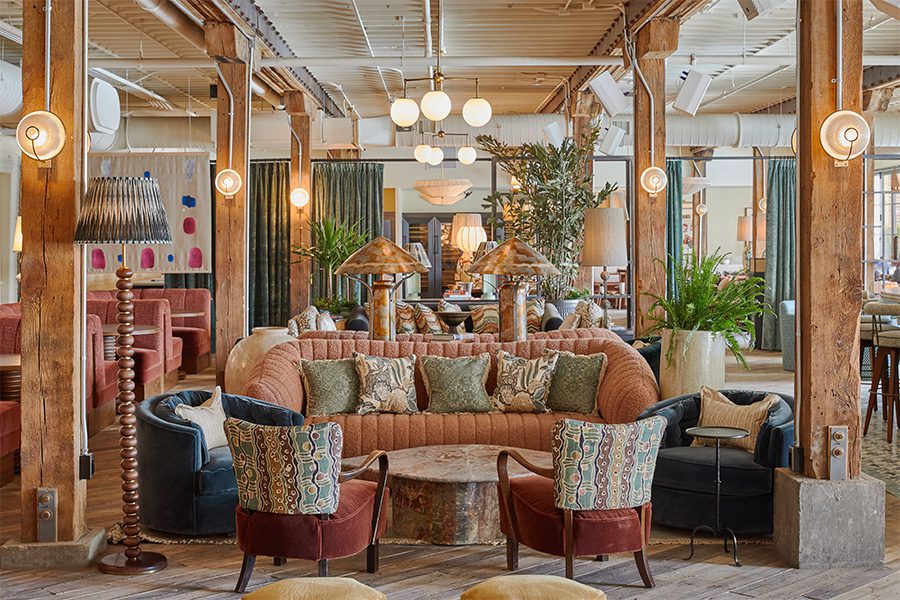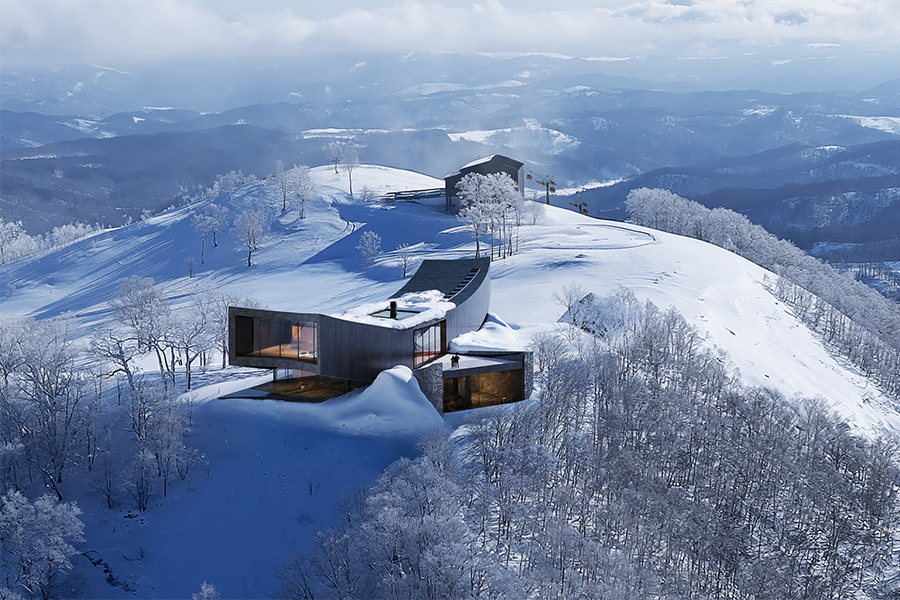Twenty years ago, Nashville rebranded itself as “Music City,” a global and cultural destination that went way beyond its country music image. Since then, the bachelorette parties have come (and not quite gone), new attractions and museums have been unveiled one after the other, and hotels have opened at a rapid pace, arriving in packs every few years. The pre-COVID bunch saw a marked predilection for boutique brands in adaptively reused spaces.
Of late, pandemic and potential recession notwithstanding, the city has managed to squeeze in more than 6,000 new rooms—this time, many from luxury brands. For the most part, they are housed in new-builds erected slightly outside of downtown, including the forthcoming spring debut of the 159-room Cambria Hotel Midtown. Designed by Venetian studio Anidride Design, it will boast a terrace bar and restaurant with panoramic city views. The 346-key W Nashville recently debuted in the entertainment and retail district of the Gulch, between downtown and Music Row. Set in a blue glass building designed by the Dallas office of HKS, its interiors come courtesy of Rockwell Group. “We adopted a design language of clean maximalism that combines pure forms with the unexpected, and the grand with the intimate,” says Kathianna Rousseau, a senior associate and director at Rockwell.
Evidenced by the handful of properties we delve into below, it seems Nashville has opened up to a new generation of travelers.
Conrad Nashville

The lobby of the Conrad Nashville
Not far from Music Row and Vanderbilt University, the Conrad opened last spring with 234 rooms as part of a new mixed-use development from Cooper Carry architects, with interiors by New York-based Champalimaud Design. The design mandate for public spaces and guestrooms was to “apply a traditional sense of luxury to the contemporary style of the brand,” says Champalimaud principal Jun Chun. So, while upon entering, guests immediately spot a grand sweeping staircase, they also encounter a thoroughly modern curved stone reception desk. An adjacent farm-to-table restaurant named for the state flower, Blue Aster, sports accents of deep blue; the same vivid hue reappears in the more casual third floor eatery, Thistle and Rye. Upstairs, guestrooms outfitted in white oak, light gray carpet, and beige headboards return to the more neutral palettes of the lobby.
Hotel Fraye, Curio Collection by Hilton

Gathre restaurant is one of two F&B venues at Hotel Fraye
A few blocks away, Hotel Fraye opened last August in another new-build (architecture comes courtesy of R2L) with interiors by EoA. The public spaces and guestrooms aim for a mix of grit and glamour, says the Coral Gables, Florida-based firm’s founder and president Malcolm Berg. “Cast iron and velvet, rawhide and bronze, concrete and lace. The mixture of the rough unfinished surfaces against the refined gilded accents and the bold colors and patterns against the deep lived-in neutrals, creates the perfect balance between masculine and feminine,” he adds. The hotel offers two restaurant and bar concepts, the seventh-floor Eddie Ate Dynamite, a rooftop lounge whose name references the beginning of a mnemonic to help guitarists tune their instruments, and the all-day, deliberately misspelled Gathre.
1 Hotel Nashville

The lobby at the 1 Hotel Nashville, featuring a design from Workshop/APD and the SH Hotels & Resorts team, is awash in black metal accents
When the highly anticipated mixed-use development from SOM that includes a Ritz-Carlton opens in 2025, a triumvirate of luxury properties will no doubt give a better sense of place to the area around the convention center. In the meantime, thanks to the brand’s distinctive biophilic ethos, nothing in town looks quite like the 215-room 1 Hotel Nashville, which debuted across from the JW Marriott that first enlivened the area in 2018.

The bar at sustainably driven restaurant 1 Kitchen at the 1 Hotel Nashville
Founding principal Matt Berman of New York-based firm Workshop/APD (which handled interior architecture and interior design for the hotel’s public spaces, restaurants, spa, meeting rooms, and guestrooms) says the lush Cumberland River Valley, historic Natchez Trace trail, and the Great Smoky Mountains “provided ample inspiration and natural materiality to draw from. You’ll find this in the organic palette and the use of wood, stone, rope, warm leather, and dark metal.” His favorite touches, he adds, include the “stacked, notched joinery detail at the elevators, which was inspired by the historic structures along the nearby Cumberland, and the elegantly curved plaster walls in the spa, inspired by caves at Ruby Falls.”
Soho House Nashville

Plush sofas and armchairs welcome guests in the club area of the hosiery mill-turned Soho House
Soho House arrived in the city last winter in an adaptive reuse of an old hosiery mill, still further afield in the artsy Wedgwood-Houston (WeHo) neighborhood. For design cues, Harriet Liley, lead designer for the brand, says she was inspired by the “contrasts between the city’s Southern country feel and its rock ’n’ roll vibe.” That juxtaposition shows up in the mixing of delicate florals and soft cottons with jewel tones and rich leathers.

Freestanding bathtubs are a highlight of Soho House’s Large guestrooms
Throughout the club’s 47 guestrooms and its numerous common areas subtle accents refer to the building’s heritage, she adds, with touches like stitch details in the bed throws, curtains that sport the bold stripes of old-fashioned athletic socks, and metal lamps made from old thread turners.
The Hermitage Hotel

ForrestPerkins preserved original details like the lobby’s Tennessee marble arches in its renovation of the Hermitage Hotel
Back downtown, the 1910 landmark Hermitage Hotel emerged this summer from the most anticipated renovation in town. The grande dame’s facelift by Dallas-based ForrestPerkins includes updates to the 122 guestrooms, its dramatic lobby, and its historic ballroom. The “awe inspiring, jaw-dropping opulence” of the lobby’s painted glass ceiling, ornate plaster, and soaring Tennessee marble arches remain, points out Toby Bishop, lead designer on the project. “We moved away from the more traditional palette of deep reds and golds toward a brighter, fresher one of soft gray and icy blues. Guestrooms lean into green accents, and the suites have a deeper blue tonality, but they’re mostly neutral and spa-like.” Ceiling medallions and chandeliers that replaced ceiling fans “continue the idea of being in an architecturally significant space.”

An opulent library is one of the perks of the Hermitage Hotel’s 1,500-square-foot Presidential suite
Separately, designer Thomas Juul-Hansen transformed the hotel’s Capital Grille outpost into Drusie & Darr, the first offering from Jean-Georges Vongerichten in the South. The same pair is behind the pretty-in-pink espresso bar-into-wine bar cafe, the Pink Hermit.
Four Seasons Hotel Nashville

A bar surrounded by tiles is one of the draws at Mimo, the Italian restaurant at Four Seasons Hotel Nashville
At the other end of downtown, not far from the riverfront and the SoBro (South Broadway) neighborhood, the 235-key Four Seasons opened last November. “Four Seasons didn’t want everything to be just about ‘Music City,’” says Jude Muhern, principal at Marzipan, the West Palm Beach firm charged with interiors. “It’s more sophisticated than people might think.”
Tapping into a tangible sense of place, the team drew inspiration from the nearby pedestrian bridge that crosses the Cumberland River, and even the sidewalks outside for a distinctly urban palette of “charcoal gray, light gray, and cream coupled with a simple but large-scale zigzag chevron pattern in the guestroom carpeting,” according to Molly Duun, design director for the project. Music is subtly referenced, though, in a round custom end table whose dark coloration and grooves evoke a vinyl record, especially as lit by an arching lamp that suggests a turntable’s stylus.
The designers add that they are particularly enamored of ground-floor Italian restaurant Mimo. “Its design is totally Nashville,” says Mulhern. “The wood inlay floor, bar-front tiles, and cane chairs reference that whole makers thing, while the warm palette and rustic materials like copper feel Italian but in an edgy, industrial way.”

Mimo’s vibe is at once airy, warm, and edgy
This article originally appeared in HD’s February/March 2023 issue.



